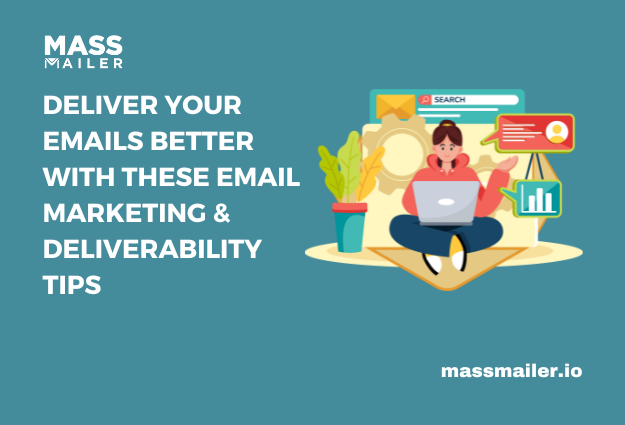Table of Contents
A recent study suggests that 16.9% of marketing emails never reach the recipients’ inboxes. This is why an increasing number of email marketers today use email deliverability metrics to determine whether or not their emails are reaching their customers.

The concept of email deliverability exists primarily to prevent email spam and protect users from it. From a client’s perspective, too, it’s the responsibility of an email marketer or a business to protect their users’ privacy and create a better email experience by filtering out spam or undesired content.
To help you navigate this space better, we will learn more about email deliverability here and share some of the top email marketing and deliverability tips to help you strengthen your email marketing campaigns.
What is Email Deliverability?
Email deliverability refers to a measure of how many emails reach your subscribers’ inboxes. It is often expressed as a percentage and gives you the number of emails your subscribers see right in their inboxes without checking their spam or junk folders.
A recent study found that the average email deliverability is between 83 and 89%. Several factors can affect this email deliverability rate. Among some of these are:
-
Sender reputation
A sender’s reputation is a metric that tells email servers about the overall quality of email coming from the respective domain. In case spam emails start from your email address, there will be a penalty for the same.
-
Email content
Email content is another factor that can significantly affect the overall deliverability. Servers can consider your messages spam if you use too many links or spammy words (such as “free,” “act now,” and “limited time”) or other content, such as unsolicited emails, phishing, and spoofing.
Guide on Deliver Your Emails Better with These Email Marketing & Deliverability Tips
Email Sending Tips and Best Practices
Here are some of email marketing and email sending best practices to keep your sender reputation and email deliverability healthy:
1. Authenticate your domain and IP
Email domain and IP authentication tell a recipient’s server that your email originates from a legitimate and relevant source. Failing this, your emails won’t reach the recipient’s inbox at all and can trigger spam filters, thus impacting deliverability.
2. Implement SPF, DKIM, and DMARC for email deliverability
There are multiple ways to follow email authentication protocols when validating your email domain and IP address. Some of the most common ones are discussed below:
- SPF or Sender Policy Framework
Sender Policy Framework (SPF) is an authentication method that helps you verify whether an email is originating from a legitimate sender. You can use SPF to specify the mail server from which you send emails.
- DKIM
DKIM, or DomainKeys Identified Mail, is an authentication mechanism that works like a digital signature for organizations. It allows marketers to confirm if their emails are legitimately received from that company and not from scammers.
- DMARC, or Domain-based Message Authentication, Reporting, and Conformance
DMARC is another excellent mechanism for safeguarding email senders and recipients from malicious spoofing attacks. The protocol uses a combination of SPF and DKIM techniques during email validation.
3. Warm up your IP and domain
Businesses typically send all emails through IP addresses. However, when you use a shared IP address, its performance is significantly affected by other parties using that particular IP pool. Therefore, it is best to invest in a dedicated IP to ensure that results are not negatively impacted.
Apart from this, also make sure to:
- Monitor your domain and IP reputation
- Monitor your domain and IP for blacklist
- Use a separate domain and IP for prospecting emails
- Check email content and send both HTML and TEXT versions of your email
- Preview your emails to various email clients
- Let people view email on a web browser
- Add an email signature with the address in your emails
4. Add unsubscribe links in your emails
Regardless of how long it takes to get an email lead, there should be an easy way to stop it if the recipient no longer wants to receive your emails. You can do this by including an easily accessible unsubscribe link in every email that allows users to opt-out.
Apart from this, also make sure to:
- Do not use large images in your email
- Do not use all email caps in your content
- Click the links in your emails for blacklist
Other Email Deliverability Best Practices
Other than the above, here are some of the other email-sending best practices you can follow to improve email marketing and deliverability campaigns:
1. Test your emails before sending them
Make sure to test your emails before sending them to identify and correct any information that might have been incorrectly put without taking into consideration the concept of email deliverability. Additionally, make sure to:
- Include the recipient’s name in the To: field
- Send retarget campaigns to low-engaged subscribers
- Don’t use a generic sender email address
- Audit your email deliverability
- Honor unsubscribes and remove them from your email lists
- Don’t email bounced email addresses repeatedly
2. Send emails at the right intervals
It is also important to send emails at the right intervals or in regular patterns to avoid spamming your recipients. While sending emails at different times for international clients may still be required, the idea here is not to spam them randomly and then disappear for a long time.
3. Use a good target list
Maintain a high-quality and relevant email list by regularly removing bounced email addresses, inactive subscribers, and any email addresses that have marked your emails as spam.
4. Don’t build email lists by scraping sites
Even though there are legal ways to purchase or rent email lists, it’s best to avoid them as it can significantly harm your email deliverability rates and can lead to a high spam complaint rate.
5. Segment your email lists
Segmentation of your email lists allows you to send better and more relevant content to specific groups within your audience. Personalizing your communications as per the interests of different segments can also help you improve customer engagement rates, which in turn can positively impact your email deliverability.
Learn more about email deliverability best practices here.
To Conclude
Improved email deliverability and better email marketing campaigns start with safe and relevant newsletter content and a healthy subscriber list. When your emails are checked for all the above-said pointers and sent from proper and valid addresses, you can improve your email deliverability rates manifolds.
The key here is to respect the email inbox, and you will be rewarded adequately.
About MassMailer
MassMailer is a powerful email marketing solution provider that allows organizations to send bulk emails with ease. Contact us if you wish to take your business to new heights by emailing MassMailer.


 View Presentation
View Presentation